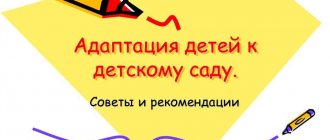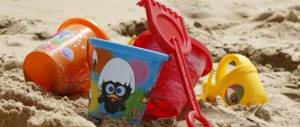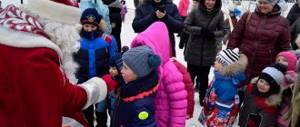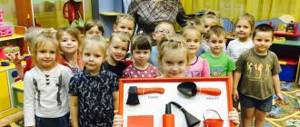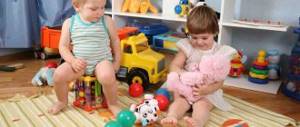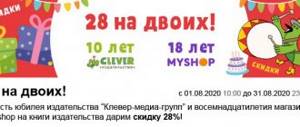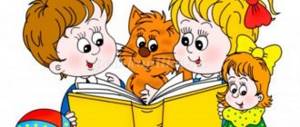The main task of games during this period is the formation of emotional contact and children’s trust in the teacher. The child should see in the teacher a kind person, always ready to help (like a mother) and an interesting partner in the game. Emotional communication arises on the basis of joint actions accompanied by a smile, affectionate intonation and a manifestation of care for each child. The first games should be frontal, so that no child feels deprived of attention. The initiator of all games is an adult. Games are selected taking into account the children's playing abilities, location, etc.
Didactic games
The games below will not only encourage the timid and cheer up the crying one, but will also calm the overly naughty child, redirect attention and help relax the angry, aggressive child.
Playing with a dog
Material. Toy dog.
Progress of the game. The teacher holds the dog in his hands and says:
Bow-wow! Who's there? This is a dog visiting us. I put the dog on the floor. Give Petya a paw, little dog! Then he approaches the child, whose name is named, with the dog and offers to take it by the paw and feed it. They bring a bowl of imaginary food, the dog “eats soup,” “barks,” and says “thank you!” to the child.
When repeating the game, the teacher calls the name of another child.
Collecting "treasures"
Material. Basket.
Progress of the game. During a walk, the teacher collects “treasures” (pebbles, pods, twigs, leaves, shells) with the child and puts them in a basket. Finds out which “treasures” arouse the greatest interest in the baby (this will suggest further ways of communication). Then he names some “treasure” and asks to take it out of the basket.
Making a collage
Material. Scraps of colored paper, greeting cards, string, pieces of foam, yarn, etc.
Progress of the game. The teacher spreads a large sheet of thick paper or cardboard on the table. Using a brush, coat a piece of foam plastic (postcard, etc.) with glue on one side and hand it to the child to stick it on the paper. Allows the child to choose the items he would like to stick on. After carefully observing the actions of an adult, the child will be able to apply the glue himself. The completed collage can be hung in a prominent place for everyone to admire.
(The game helps develop creative skills.)
Caught a fish
Material. Cardboard box, metal bottle caps (“fish”), magnet, stick and rope (for a fishing rod).
Progress of the game. Several metal bottle caps, preferably of different colors, are placed in a cardboard box. A stick is tied to one end of the rope (or ribbon), and a magnet bar is tied to the other. The teacher shows the child how to fish “fish” out of the box by attracting metal plugs with a magnet. If the corks are different colors, then the baby can be asked to pull out, for example, a red fish.
After all the plugs have been removed, the adult counts them (“That’s how many fish we caught!”), and the game starts over.
(The game helps develop coordination of movements.)
Let's ride a horse
Material. Rocking horse (if there is no horse, you can sit the child on your lap).
Progress of the game. The teacher puts the child on a rocking horse and says: “Masha is riding a horse, (says in a quiet voice) no-no.” The child repeats quietly: “No-no.” Adult: “To make the horse run faster, tell it loudly: “No-no, run, little horse!” (Swings the child more strongly.) The child repeats the phrase together with the teacher, then independently. The adult ensures that the child pronounces the sound “n” drawn out, and the entire sound combination loudly and clearly.
(The game develops speech activity).
Blow into or onto something
Progress of the game. The teacher blows on a small balloon through a straw, causing it to move around the room. Blows on all fingers, then on each one separately. Blows a leaf from the child's palm. Blows on a flower or blade of grass. The child repeats the actions of the adult.
Blow on the balloon, blow on the pinwheel, blow on the horn
Material. Balloon, pinwheel, horn.
Progress of the game. A balloon is suspended at the level of the child’s face, and a pinwheel and a horn are placed on the table in front of him. The teacher shows how to blow on a balloon so that it flies high, and invites the child to repeat the action. Then the adult blows on the turntable to make it spin, blows the horn, and the child repeats.
(The game promotes the development of the speech apparatus).
Book - guess what?
Material. Notebook with spiral wire.
Progress of the game. Paste pictures of objects known to the child across the page (on the right side) in the notebook. Each page without pictures is cut into several horizontal strips, starting from the left edge. Looking at the book with the baby, the teacher gradually turns away strip after strip. The child tries to guess what is shown in the picture.
(The game develops imagination and logical thinking).
Fun with a magnifying glass
Material. Magnifying glass (preferably plastic).
Progress of the game. During a walk, the teacher gives the child a blade of grass. Shows how to look at it through a magnifying glass. Invites the child to look through a magnifying glass at fingers and nails - this usually fascinates the baby. While walking around the site, you can examine a flower or the bark of a tree, examine a piece of earth: are there any insects there, etc.
(The game develops observation skills).
Walking along the outlines of different figures
Material. Wide dense tape (braid).
Progress of the game. Using tape, circles, squares, triangles, etc. are depicted on the floor. The teacher shows the child how to walk along the tape (start with a circle). An adult takes the baby by the hand, walks with him and sings to any tune: “We are walking in a circle, tra-la-la, tra-la-la. We go in a circle, tra-la-la, tra-la-la." This is how all the figures pass. Then the teacher tries to walk along them with the child, walking backwards, sideways, on tiptoes, jumping over the figure, etc.
(The game contributes to the development of ideas about objects).
Together with the bear
Material. Toy bear.
Progress of the game. The teacher talks “as equals” with the bear and the child, for example: “Katya, do you like drinking from a cup?”, “Misha, I like it. Knocks fist on fist, claps his hands. Alternating such actions, the teacher creates a certain sequence of sounds, for example: knock-clap, knock-knock-clap, knock-clap-clap, etc.
What to do with a 6-9 month old baby
With the greatest interest in the second half of life, children find out the relationships of objects with each other: how large toys relate to small ones and how small objects can be placed in large ones. Improving the skills of hands and fingers allows the child to invent various combination games with 1 toys - knocking one on the other, piling toys into a pile and (the most favorite activity) filling and emptying certain containers. The ability to manipulate two toys at the same time opens up almost endless play possibilities for the baby. Give your child a large plastic bucket or shoebox and watch as she tries to fill the containers with whatever comes her way. Now watch how the baby combines the cube and the container. His mind and hands work together, figuring out how to put the cube in the box and, of course, how to take it out. After playing “put it in and take it out,” he will begin to shake the cube in the container, getting great pleasure from the sound that is heard. Look how attentive and concentrated the expression on the child’s face became when he was busy with these game combinations.
- Bring pots and pans from the kitchen (we recommend filling your ears with cotton wool first!). The baby will be delighted with the opportunity to put a small saucepan in a large one and, of course, rattle them.
- Playing with the faucet and sink in the bathroom (only under your supervision!) provides an opportunity to practice pouring and pouring. Scooping up water with a cup and then pouring it out is one of the favorite pastimes of kids.
- Place your baby in a large laundry basket, half-filling it with socks and assorted baby clothes. He will empty it for a long time and with great pleasure, throwing away one thing after another. When all the laundry is on the floor, take the smallest “helper” out of the basket and show him how to “fold” everything back. Pick up the sock and defiantly put it in the basket. The “helper”, with the same gusto as he unloaded, will begin to fill the basket again.
How to get into the mind of your own child
Oh, if only we could penetrate that little head and find out what the baby is thinking about! Well, there is something that can be done. You can learn to understand what your baby is thinking about by watching him play. By offering the child some solutions and seeing his reaction, you can restore the course of his reasoning. We call this method “bracket opening.” And these guesses are the only way until the child learns to speak. He can tell you about his thoughts using the language of facial expressions and gestures available to him at this stage of development.
Other interesting games and competitions for children (3 years old)
"Edible-inedible"
Required details:
- rubber ball.
Another interesting entertainment for children 3 years old, familiar to all adults from early childhood. Children sit on chairs, and the leader names the object and throws the ball. If the word means something edible, the child must catch the toy, or throw it away if it is inedible.
“Who said “Meow”!”
Active and noisy play will appeal to three-year-old fidgets. The birthday boy is invited to play the role of a hunter. He turns his back to the guests, and one of the participants loudly shouts: “Meow!” After this, the baby runs around the room and begins to meow loudly, and the hunter must guess who made the sound first.
"Find the Treasure"
Required details:
- plastic or cardboard coins.
Treasure hunt competitions for children's birthday parties are very popular as their adventurous nature is very popular with children. This game can be played with plastic coins or other small objects that can be conveniently hidden in or outside the house. The goal of this game for 3-year-old children should not be difficult, for example, to collect all the coins. The one who collected the most coins wins a prize.
It is better to plan competitions for children 3 years old in advance, preparing several reserve ones, in case the children require the fun to continue longer than planned, or to quickly replace a competition that children will not accept with obvious enthusiasm. After all, it is important that all those invited and the hero of the occasion himself participate in the proposed competitions with interest and joy. A good mood is the key to a successful holiday!
Games and competitions for BIRTHDAY 2 - 3 YEARS
Competitions for children from 3 years old with balloons
"Air volleyball"
Required details:
- balloons;
- bright ribbon;
- music player.
All children love to play with balloons, so competitions for children's parties (3 years old) using them are a must. For this active competition you will need pre-inflated balloons and a thick ribbon that will divide the room into 2 parts. Children and adults are divided into two teams.
Kids and their parents stand on opposite sides of the “field”. Balls are laid out in equal numbers on both sides. Incendiary music plays and the participants of both teams must throw all the balls to the opponent’s side.
When the music stops, the host counts the remaining balls and announces the winner.
"Air balloons"
Required details:
- air balloons.
Before the competition begins, each child chooses their favorite ball. The presenter asks you to keep the ball in the air by hitting it with your hands, head, and feet. The main condition of the game is not to let the ball fall to the floor. The prize goes to the one who can keep the ball in the air the longest.
It will be more difficult to juggle two balls at the same time, but it will be more fun and interesting to sit on the ball and try to crush it. The prize will be given to the one who crushes the ball faster.
Entertaining a four year old
Where to go with a child over 4 years old in Moscow? Believe me, the older your child is, the more interesting you can spend time with him in the capital. We will mark just a few places on the entertainment map, and you can use our hint and add your own points to the list:
- "City of Builders" This unique attraction will be interesting not only for boys, but also for girls. After all, every kid wants to feel like an adult and do something like that with their own hands. This project is located in the Riviera shopping center and includes three zones. The first contains construction equipment that kids can operate and even build a multi-story house. Another zone is dedicated to pirates, so the child will have great pleasure in taking part in the capture of a merchant ship, learning how to tie sea knots and trying to catch a fish in a net. The next area contains dams, fountains and pools. Here you can have a lot of fun wearing waterproof vests and learn a lot about the properties of water.
- Puppet Theater named after S. V. Obraztsov. The theater, which has existed for almost a hundred years, attracts children with its unique clock with dolls. To this day, it is the largest in the world, and its performances invariably delight young spectators. Ticket prices start from four hundred rubles, the most expensive ticket costs two and a half thousand rubles.
- Park "Fairy Tale". Near Krylatskaya Street, on an area of three and a half hectares, there is a park built in the style of favorite children's cartoons. All rides, swings, carousels and water slides, including water slides, are designed for children aged three years and older. Therefore, it will be interesting and safe for four-year-olds. The kids really like the railway and rope park. The pride of Skazka is the interactive geological museum. And after all the fun, the kids will be happy to visit the petting zoo, where kind and cute animals live.
